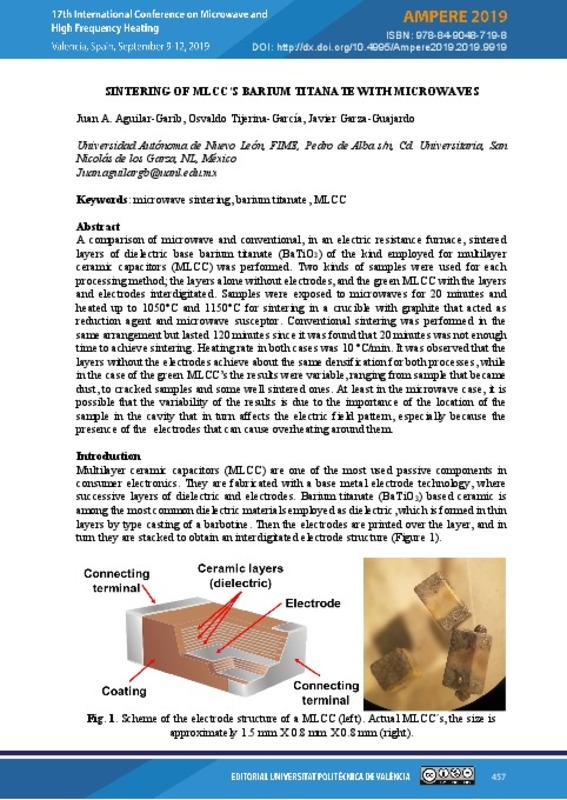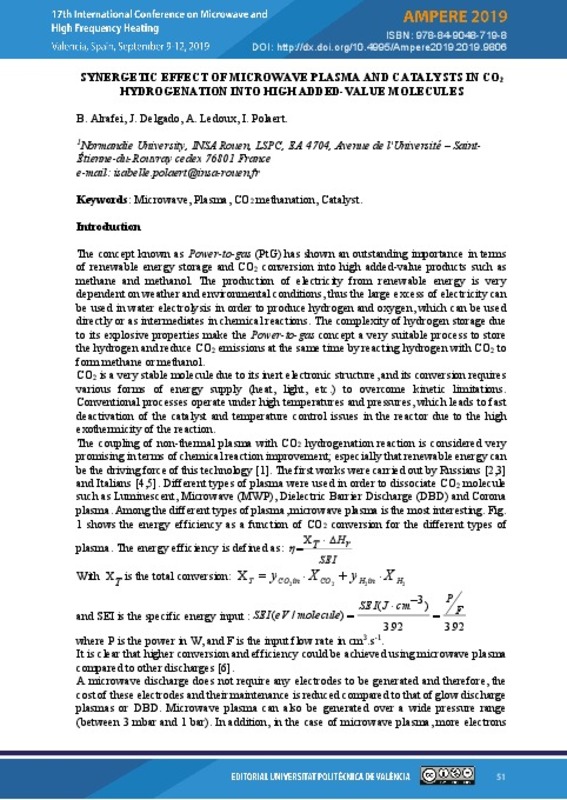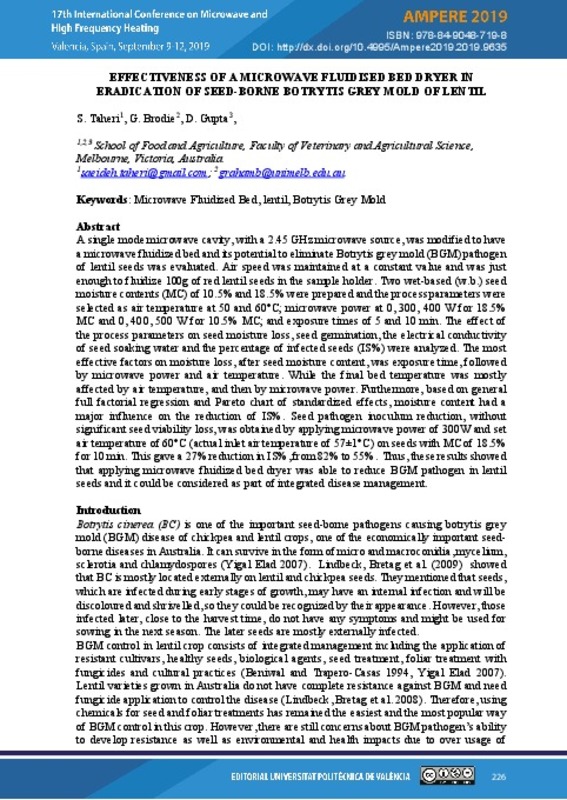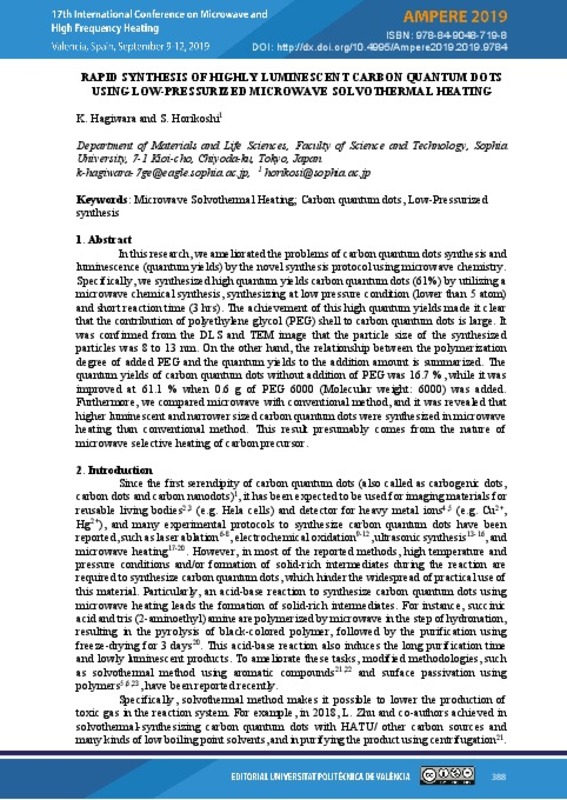JavaScript is disabled for your browser. Some features of this site may not work without it.
Buscar en RiuNet
Listar
Mi cuenta
Estadísticas
Ayuda RiuNet
Admin. UPV
Sintering of MLCC’S barium titanate with microwaves
Mostrar el registro sencillo del ítem
Ficheros en el ítem
| dc.contributor.author | Aguilar-Garib, Juan
|
es_ES |
| dc.contributor.author | Tijerina-García, Osvaldo
|
es_ES |
| dc.contributor.author | Garza-Guajardo, Javier
|
es_ES |
| dc.date.accessioned | 2019-11-13T08:06:45Z | |
| dc.date.available | 2019-11-13T08:06:45Z | |
| dc.date.issued | 2019-10-15 | |
| dc.identifier.isbn | 9788490487198 | |
| dc.identifier.uri | http://hdl.handle.net/10251/130876 | |
| dc.description.abstract | [EN] A comparison of microwave and conventional, in an electric resistance furnace, sintered layers of dielectric base barium titanate (BaTiO3) of the kind employed for multilayer ceramic capacitors (MLCC) was performed. Two kinds of samples were used for each processing method; the layers alone without electrodes, and the green MLCC with the layers and electrodes interdigitated. Samples were exposed to microwaves for 20 minutes and heated up to 1050°C and 1150°C for sintering in a crucible with graphite that acted as reduction agent and microwave susceptor. Conventional sintering was performed in the same arrangement but lasted 120 minutes since it was found that 20 minutes was not enough time to achieve sintering. Heating rate in both cases was 10 °C/min. It was observed that the layers without the electrodes achieve about the same densification for both processes, while in the case of the green MLCC’s the results were variable, ranging from sample that became dust, to cracked samples and some well sintered ones. At least in the microwave case, it is possible that the variability of the results is due to the importance of the location of the sample in the cavity that in turn affects the electric field pattern, especially because the presence of the electrodes that can cause overheating around them. | es_ES |
| dc.format.extent | 6 | es_ES |
| dc.language | Inglés | es_ES |
| dc.publisher | Editorial Universitat Politècnica de València | es_ES |
| dc.relation.ispartof | AMPERE 2019. 17th International Conference on Microwave and High Frequency Heating | es_ES |
| dc.rights | Reconocimiento - No comercial - Sin obra derivada (by-nc-nd) | es_ES |
| dc.subject | Energy Production by Microwaves | es_ES |
| dc.subject | Microwave CVD | es_ES |
| dc.subject | EM Modelling | es_ES |
| dc.subject | Microwave Material interaction | es_ES |
| dc.subject | Dielectric Properties | es_ES |
| dc.subject | Dielectric Properties Measurement | es_ES |
| dc.subject | Solid State Microwave | es_ES |
| dc.subject | Microwave Processing | es_ES |
| dc.subject | Microwave Chemistry | es_ES |
| dc.subject | Microwave applicators design | es_ES |
| dc.title | Sintering of MLCC’S barium titanate with microwaves | es_ES |
| dc.type | Capítulo de libro | es_ES |
| dc.type | Comunicación en congreso | es_ES |
| dc.identifier.doi | 10.4995/AMPERE2019.2019.9919 | |
| dc.rights.accessRights | Abierto | es_ES |
| dc.description.bibliographicCitation | Aguilar-Garib, J.; Tijerina-García, O.; Garza-Guajardo, J. (2019). Sintering of MLCC’S barium titanate with microwaves. En AMPERE 2019. 17th International Conference on Microwave and High Frequency Heating. Editorial Universitat Politècnica de València. 457-462. https://doi.org/10.4995/AMPERE2019.2019.9919 | es_ES |
| dc.description.accrualMethod | OCS | es_ES |
| dc.relation.conferencename | Ampere 2019 | es_ES |
| dc.relation.conferencedate | Septiembre 09-12,2019 | es_ES |
| dc.relation.conferenceplace | Valencia, Spain | es_ES |
| dc.relation.publisherversion | http://ocs.editorial.upv.es/index.php/AMPERE2019/AMPERE2019/paper/view/9919 | es_ES |
| dc.description.upvformatpinicio | 457 | es_ES |
| dc.description.upvformatpfin | 462 | es_ES |
| dc.type.version | info:eu-repo/semantics/publishedVersion | es_ES |
| dc.relation.pasarela | OCS\9919 | es_ES |
Este ítem aparece en la(s) siguiente(s) colección(ones)
-
Ampere 2019 [66]











